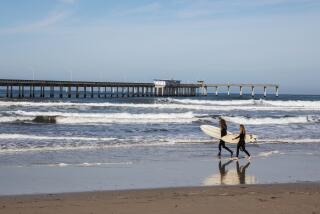Ocean Institute Ready to Say ‘Ahoy, Mate’ to Schoolchildren
- Share via
Seventy teachers interrupted their summer vacations for a sneak preview of the nearly completed expansion of the Ocean Institute in Dana Point.
The recent two-hour tour of the $16.5-million waterfront education center’s remodel left many of the instructors wide-eyed, eager to get back to school and sign their students up for institute programs, which are unique in California for their in-depth educational content.
“I’ve been coming here for 20 years, and I’m just blown away by this,” said Paulette Powell, a second-grade teacher in Moreno Valley. “The potential for encouraging and inspiring kids is limitless. There is such a potential for making science come alive.”
The institute, at the west end of Dana Point Harbor, is five times larger than its predecessor, a 20-year-old marine science center that was knocked down last year. The research campus now consists of six buildings. An estimated 135,000 Southern California students a year are expected to visit the institute’s marine labs, travel on research vessels or spend a night on the tall ship Pilgrim once the facility reopens in October for educational visits.
“This is the culmination of a long journey for this organization,” said Harry Helling, vice president of education and research for the institute. “We’re the lab ... every school would love to have but can’t afford.”
Unlike similar facilities in San Diego, San Pedro and elsewhere on the California coast, the institute has the aim of providing detailed instruction on the ocean and coastal environment for children in kindergarten through 12th grade. Whereas other marine museums and aquariums provide displays tailored to the wider public or to research, the Dana Point institute is geared toward field trips in which children average nearly seven hours per visit.
“We gear all our tanks and exhibits toward helping support our educational programs,” said Deidre Cavazzi, the institute’s curriculum coordinator.
In the next several weeks, the project, which has taken about 18 months, will enter its final stages, which include filling and stocking the tanks. The work was privately funded with contributions that included a $5.5-million gift from philanthropists Henry and Susan Samueli and $4 million from an anonymous donor. In the past, the research institute had relied mostly on grants from the city and state for its operations.
Ocean Institute officials originally considered building a “Monterey Bay-style aquarium,” a reference to the massive tourist mecca along the central coast city’s Cannery Row.
“The community and the teachers gave us a resounding ‘no’ to the aquarium idea,” institute spokesman Bentley Cavazzi said. “They wanted us to focus on the teaching aspect.”
Teachers who previewed the facility seemed convinced that the focus was in the right place.
Christine Clark, a science teacher at La Habra’s Sonora High School, said she was impressed that students will be treated as researchers. “This won’t be your typical show-and-tell field trip,” she said.
That became evident as instructors viewed the surf science center overlooking the ocean, which will give fourth-and fifth-graders a chance to spend the night just steps from the breaking waves in a surf-themed tent cabin on surfboard-shaped mats. Students will discover what makes a perfect wave and will track storms at sea in a National Weather Service-certified observation station.
A children’s theater in the ecology learning center will take students virtually underwater in an outdoor intertidal pool that simulates wave action and features a collection of local coastal organisms. The sea-floor program allows students to explore what appear to be the ice fields of Europa and conduct underwater excavation of a city.
For those who can’t make the trip to Dana Point, the institute can link off-site classrooms to real-time experiments at the center or on one of its research ships.
The center is also expanding its overnight programs to include three-day trips recreating the 19th century voyage of the HMS Challenger as well as a Catalina Island Ecology Safari and a Civil War reenactment.
Students will travel aboard the Spirit of Dana Point and the research vessel Sea Explorer. The Pilgrim, a working replica of the 130-foot brig that carried author Richard Henry Dana along the California coast in the early 1800s, will continue to hold overnight programs.
One of the goals of the Samueli Foundation is to ensure that more children from low-income families can visit the center. The institute’s board has launched an adopt-a-class program giving local businesses an opportunity to sponsor trips.
More to Read
Sign up for Essential California
The most important California stories and recommendations in your inbox every morning.
You may occasionally receive promotional content from the Los Angeles Times.













